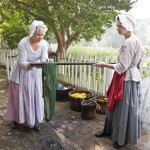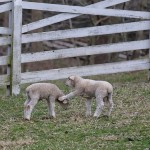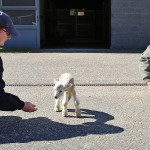Once lambing is over for the season, sheep in need of a haircut (shearing) will be led over to a small enclosure adjacent to the Weaver’s Shop. Leicester Longwools are bred for quality meat, but also for their wool. But where does all that fleece end up?
Many of the historic trades have specific uses for the wool. The milliners, for example, sometimes use wool to puff up embroidery, giving it a little bit more body. Our printers use wool to stuff their ink balls, which they then use to apply ink on the printing press.
The military artificers use wool to make their leather goods a little bit more comfortable. You may spot a hat with wool padding stuffed into the top, although Journeyman Artificer Jay Howlett says he’ll use anything readily available. Nearby, there’s also a saddle stuffed with a sufficient quantity of the white stuff to promise a gentler ride.
The Basketmakers have been using some for pincushions. Belly wool is the best for stuffing. And that’s what is beneath the fabric covering in what looks like a tiny handcrafted picnic basket. Some crafters say the lanolin in the wool prevents rusting in the pins.
Most of the wool will pass through the Weaver’s Shop, where it is spun, dyed, and woven into fabric. Karen Clancy, Master of the Shop, estimates that they use 60 to 70 lbs. of it a year.
An adult sheep might yield 15 lbs., while a youngster offers 6-8 lbs. of lambswool. Of course, that’s because wool grease weighs a lot. That grease is lanolin, which insulates sheep from the elements by helping them shed water. Sheep hate to carry umbrellas.
The yield is considerably smaller once the wool is cleaned. There are two classic ways to clean wool. One is to just rinse it in water. Preferably warm water, says Karen, and if it’s particularly dirty, you can use a mild soap.
In his 1765 “Treatise on the Propagation of Sheep,” printed right here in Williamsburg (a facsimile from our Print Shop is available in the Post Office), John Wily suggested another method:
[M]ake a Pen near some Water Course or Pond, and wash your Sheep before you shear them: As soon as they are washed turn them into a small Enclosure that has a Plenty of Grass, and let them run on it two or three Days, or until you see the fatty or oily Substance shedding amongst the Wool. Then is the proper Time to shear them.
The weavers do make some fabric out of the wool. If there’s a sufficient quantity available, lambswool is best for anything that might go next to your skin, such as socks, hats, or kerchiefs. Rougher wool can be used for items like jackets or blankets. Leg wool is good for rug-making because it is particularly coarse.
It also turns out that the Leicester Longwools boast the shiniest wool of any breed of sheep. It’s the Cadillac of lustrous fleece, says Karen.
If you are one of the millions who work or play in the fiber arts realm, you might be interested in the colorful handspun and hand-dyed skeins of yarn available in the Prentis Store. There are different weights for knitting, needlepoint, and embroidery.
There’s also batting, which is good for quilting and is typically made up of the coarser wool of older sheep.
There’s more than the yarn, pincushions, and batting available at Prentis Store. If you’re just looking for a souvenir—let’s call it a sheepsake—there are packages of Leicester Longwool Locks.
There are undoubtedly many other uses for the Leicester Longwool’s fleece around town, demonstrating its utilitarian value. Even some of our feathered residents find it useful, plucking stray pieces of wool to line their nests.



Jean H says
And you can knit a sweater.
Love everything you are posting! I watch the web cams almost daily, and always hope to see the sheep near the Market House since it was said you take some there to show the public. If you take them to the back corner of the gravel on the side nearest the Courthouse, they will show (or anywhere between camera and courthouse, but of course closer to camera is better). I would also need to know the schedule of their appearance. P.S. The camera lens/window needs cleaning. Some areas of the view are quite blurred. Thanks!!
I love the web cams too. A few more cameras would be a wonderful addition for those of us who between visits need our Williamsburg experience..
Yes! Another web cam fan! I watch from California, so I have a three hour time difference. I always hope to catch a glimpse of a carriage, characters, or signs of an event. Just watching the leaves change and the snowfall is fun. Watching George Washington’s tent making and the progress on the Market House were great. In between I just enjoy getting a feel of the rhythm of the community. These are a great but underused marketing tool. Wish we could have more, and have them aimed at areas of action!!
I gree with Ms. Rapp. Keep it up to date.
I’m one of those fiber enthusiasts. I spun a batt of LL a couple of years ago, and can attest to its long staple length and shininess. Do you ever sell lamb’s fleece, whether washed or in the grease?
I’ll inquire with the weavers, but I believe we use everything we have beyond the items mentioned for sale at Prentis.
I’m informed that we do sometimes sell fleece as it is available. I will email you contact info separately.
I love this series on sheep! And PLEASE-PLEASE-PLEASE keep us updated on Edmund!
We will. Stay tuned!